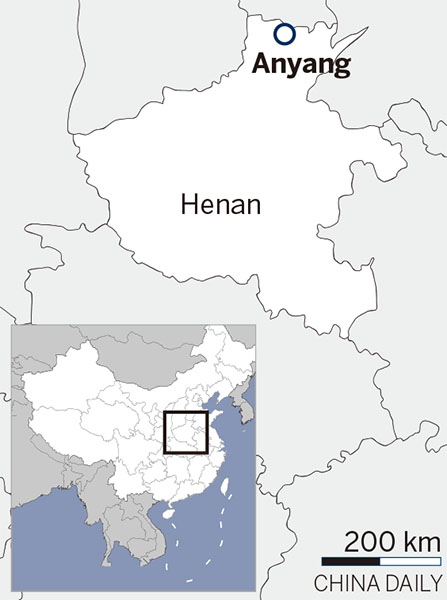

An endless journey
Yinxu may be larger than people usually think. The archaeological research of recent years has continuously added to the map of Dayishang and beyond what were once considered to be its boundaries.
According to Niu Shishan, a researcher with the CASS Institute of Archaeology in charge of excavations at Yinxu Ruins, the discovery of urban road networks and ditches made since the turn of the century has, so far, pushed those "boundaries" outward by several kilometers on all four sides of the city.
"And, the last decade has also borne witness to key findings within the city," he adds. "Over 3,000 sacrificial pits and burial pits have been found in the royal mausoleum. A garden with an artificial lake, which is over 50,000 sq m, was found to the west of the palace area."
New findings at the Yinxu royal mausoleum were listed among China's Top 10 Archaeological Discoveries of 2022 by China Cultural Relic News and the Archaeological Society of China.
The ruins of a super-sized bronze casting workshop, spreading over 70 hectares about 9 km to the northeast of Yinxu, are thought to be those of the world's largest facility of its kind during its time.
"Archaeological evidence shows that, in its time, Yinxu was the largest city in East Asia," Niu says. "This top-tier metropolis was also surrounded by smaller second- and third-tier satellite cities."
Archaeologists have excavated about five percent of the total area within the Yinxu Ruins site. Though this percentage is higher than most large-scale ancient city ruins in China due to the length of time spent researching the site, Chen, the museum director, notes that many unsolved puzzles still exist.
"As the exhibits indicate, a lot of excavated items from Yinxu were previously unseen," he explains. "We don't know what they're used for. Numerous gaps exist in our understanding of the society, politics, and culture of Shang. Some evidence may still be buried underground, and some may have disappeared forever.
"For people today, it's impossible to get a full picture of the Shang Dynasty, but our endless journey toward that goal will continue for generations to come," Chen says.
The archaeologist He expects the Yinxu Museum will provide a new technical facility for detailed archaeological studies under laboratory conditions.
"Visitors can also view our ongoing studies in the near future," He says, referring to a locked area of the museum. "It's the duty of the archaeologists to brief the public on our latest findings."